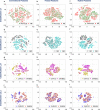Phenotyping neuroblastoma cells through intelligent scrutiny of stain-free biomarkers in holographic flow cytometry
- PMID: 37753527
- PMCID: PMC10519746
- DOI: 10.1063/5.0159399
Phenotyping neuroblastoma cells through intelligent scrutiny of stain-free biomarkers in holographic flow cytometry
Abstract
To efficiently tackle certain tumor types, finding new biomarkers for rapid and complete phenotyping of cancer cells is highly demanded. This is especially the case for the most common pediatric solid tumor of the sympathetic nervous system, namely, neuroblastoma (NB). Liquid biopsy is in principle a very promising tool for this purpose, but usually enrichment and isolation of circulating tumor cells in such patients remain difficult due to the unavailability of universal NB cell-specific surface markers. Here, we show that rapid screening and phenotyping of NB cells through stain-free biomarkers supported by artificial intelligence is a viable route for liquid biopsy. We demonstrate the concept through a flow cytometry based on label-free holographic quantitative phase-contrast microscopy empowered by machine learning. In detail, we exploit a hierarchical decision scheme where at first level NB cells are classified from monocytes with 97.9% accuracy. Then we demonstrate that different phenotypes are discriminated within NB class. Indeed, for each cell classified as NB its belonging to one of four NB sub-populations (i.e., CHP212, SKNBE2, SHSY5Y, and SKNSH) is evaluated thus achieving accuracy in the range 73.6%-89.1%. The achieved results solve the realistic problem related to the identification circulating tumor cell, i.e., the possibility to recognize and detect tumor cells morphologically similar to blood cells, which is the core issue in liquid biopsy based on stain-free microscopy. The presented approach operates at lab-on-chip scale and emulates real-world scenarios, thus representing a future route for liquid biopsy by exploiting intelligent biomedical imaging.
© 2023 Author(s).
Conflict of interest statement
The authors have no conflicts to disclose.
Figures






Similar articles
-
Label-free liquid biopsy through the identification of tumor cells by machine learning-powered tomographic phase imaging flow cytometry.Sci Rep. 2023 Apr 13;13(1):6042. doi: 10.1038/s41598-023-32110-9. Sci Rep. 2023. PMID: 37055398 Free PMC article.
-
Real-Time Stain-Free Classification of Cancer Cells and Blood Cells Using Interferometric Phase Microscopy and Machine Learning.Cytometry A. 2021 May;99(5):511-523. doi: 10.1002/cyto.a.24227. Epub 2020 Oct 13. Cytometry A. 2021. PMID: 32910546
-
AI-aided holographic flow cytometry for label-free identification of ovarian cancer cells in the presence of unbalanced datasets.APL Bioeng. 2023 Jun 7;7(2):026110. doi: 10.1063/5.0153413. eCollection 2023 Jun. APL Bioeng. 2023. PMID: 37305657 Free PMC article.
-
Advances in liquid biopsy in neuroblastoma.Fundam Res. 2022 Aug 17;2(6):903-917. doi: 10.1016/j.fmre.2022.08.005. eCollection 2022 Nov. Fundam Res. 2022. PMID: 38933377 Free PMC article. Review.
-
Biomarkers in Neuroblastoma: An Insight into Their Potential Diagnostic and Prognostic Utilities.Curr Treat Options Oncol. 2021 Sep 27;22(11):102. doi: 10.1007/s11864-021-00898-1. Curr Treat Options Oncol. 2021. PMID: 34580780 Review.
Cited by
-
Rapid flowing cells localization enabled by spatiotemporal manipulation of their holographic patterns.APL Bioeng. 2024 Sep 10;8(3):036114. doi: 10.1063/5.0222932. eCollection 2024 Sep. APL Bioeng. 2024. PMID: 39263370 Free PMC article.
-
Imaging flow cytometry reveals the mechanism of equine arteritis virus entry and internalization.Sci Rep. 2025 Jan 25;15(1):3246. doi: 10.1038/s41598-025-87080-x. Sci Rep. 2025. PMID: 39863680 Free PMC article.
-
Classifying breast cancer and fibroadenoma tissue biopsies from paraffined stain-free slides by fractal biomarkers in Fourier Ptychographic Microscopy.Comput Struct Biotechnol J. 2024 Mar 24;24:225-236. doi: 10.1016/j.csbj.2024.03.019. eCollection 2024 Dec. Comput Struct Biotechnol J. 2024. PMID: 38572166 Free PMC article.
References
LinkOut - more resources
Full Text Sources
Miscellaneous

